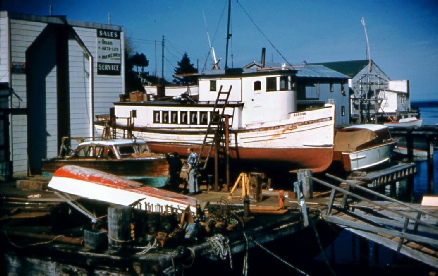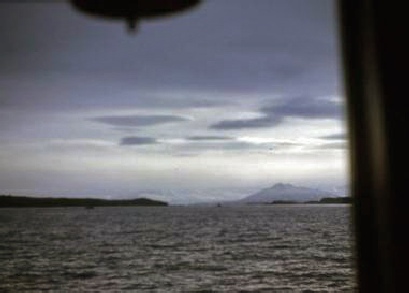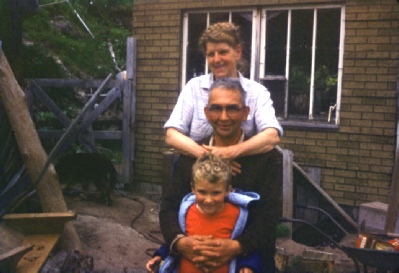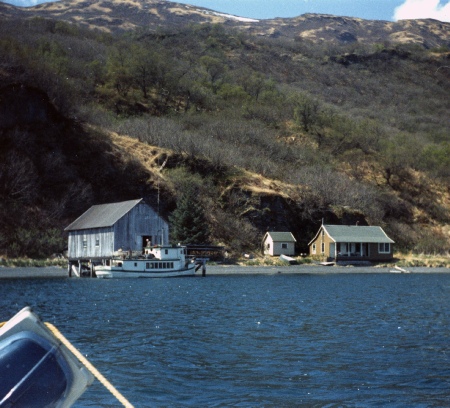Evangel Island Journey 7 -
(Harvester Island, Zachar Bay, Uganik Bay, Village Islands)
The Evangel’s Journeys to Favorite Stops Along Shelikof Strait
By Timothy Smith (revised in 2020)
Introduction: Preparing the EVANGEL for Sea Voyages
Author’s note: The time period of this article is of a typical trip we usually took
in the spring: heading from Larsen Bay to the town of Kodiak by way of all our usual
stops in the bays and islands on the Kodiak Island side of Shelikof Strait, a fifty
mile-
Rev. Norman Smith had unique responsibilities as the captain of the Evangel. Keeping
a wooden boat seaworthy in the North Pacific is a time-
The photos show the rare times when the Evangel was hauled out of the water for repairs. Normally, we beached the boat on a nice sandy shoreline and painted the hull, as depicted in the articles on Larsen Bay.
Below left: in a storm in the winter of 1957-


Shelikof Strait Stops: Heading Out Into Uyak Bay

About the photo:
It was always exciting to start the engine, untie the lines and head back out to sea. This photo was taken through the open window of the Evangel’s pilot house (in waters near Kodiak). The ship’s bell hangs above. Dad often opened the front pilot house window in good weather, to catch the brisk breezes off the ocean. (Date unknown)
Scenes of Harvester Island
Harvester Island, at the opening of Larsen Bay and within sight of our neighborhood, was the homestead of Edith and Lloyd “Swanie” Swan, and a favorite place for my older siblings to visit, partly because of their menagerie of animals.
It is finally springtime, or at least my older siblings are out of school. It is early May, and in the tradition of the village schools, there won’t be another school day until early September. But the plants and trees won’t sport full green leaves for another month and a half. Families all around the island are repairing the nets, painting the seiner or heading out to the gill net site to see how the cabin fared the winter. The Smith family is no exception. Dad has gone to the Evangel and fired up the oil stove to help rid the boat of the winter mustiness. He is checking tide tables to see when would be the best time to slap a new coat of copper bottom paint on her. And we are packing up clothes, hymnbooks, filmstrip projectors and the rest of our gear for another summer of travel adventures aboard the Evangel. After a couple of days of bustle and preparation, the time finally comes to let loose the tie lines and head out.
When the engine starts, and especially when the Evangel pulls away from the dock,
I always feel a strong sense of excitement at the adventure that always awaits. Most
of our destinations are not far from each other this time (such as the long open-
Edith Swan is one of our family friends, and a strong Christian, and she and her
husband (we always call him “Swanie”) have quite a menagerie of interesting animals
at their homestead. A pet crow, a diving dog, a couple of semi-
Our destination is a mothballed herring cannery at Zachar Bay, where our friends
the Imlochs serve as watchmen and caretakers. It is Dad’s intention to cut across
Uyak Bay and down into Zachar, tie up at the old cannery dock, catch some sleep,
and then visit the Imlochs in the morning. They are long-




Top: the Swan homestead on Harvester Island. Left: My brother Noel with Bozo the diving dog. Lower Left: “Swanie” with a chicken and two magpies. Below: My sister Robin, “Swanie,” and Binkie the lamb.

Mrs. Imloch gave Mom a page from her scrapbook, featuring Chester the bear. These photos were taken in 1959 at the Zachar Bay cannery. Her experience with Chester became an article in the “Alaska Sportsman” magazine sometime after these photos were taken.
We don’t get a chance to see Chester, because as we are sailing down the bay, we meet the Imlochs in their boat, heading out! There is a midnight visit in the bay, with the two boats tied together, and coffee and sodas and cookies all around. I hear the laughter and bits of animated conversation in the dim twilight which passes for nighttime this time of year, but I’m too tired to hop out of bed and go aboard. I’m sound asleep by the time the two boats part company. Dad later ties up to a “dolphin” (piling stuck out in the bay for mooring or navigational purposes) and catches a few hours of sleep.
When I wake up, we are already on our way to our next stop: Uganik Bay’s San Juan
cannery and what we call the “Village Islands,” a collection of homesteads and bear
camps scattered along the bays and inlets. Mom is about to serve breakfast when
we pass Little River Rock, a full-

Little River Rock is a fine place to be a sea lion! We always liked to pass by close enough to watch them and even hear them. Seeing wildlife such as seals, sea lions, porpoises, killer whales, and right whales, as well as multiple species of sea birds, was a common, daily occurrence while we traveled on the Evangel. But it was one of the things I most enjoyed about boat travel.
We turn southeast into Uganik Bay and dock at San Juan cannery, the home of a fleet
of emerald green and white seiners (the Evangel’s color scheme is white with “San
Juan” green trim, but our home base is among the Halloween-
By late that evening, the weather has changed for the worse. We stay a little longer than we expected, because a major gale kicks up, and no one is traveling. We all have a hard time sleeping in the drafty boat, due to the howling wind, creaking tie up lines, and the only somewhat effective old tires we use as bumpers to keep from smashing into the pilings of the dock. We wake up feeling like we slept on a flatbed truck as it drove on a road of potholes. In the morning, I try to walk around on the dock, but the wind takes my breath away, and the williwaws (sudden downdrafts which roar off the mountains) are so strong that the only way to walk is to lean into the wind and crawl along.
Another night and the weather is calm again, the sun is bright and there seems to
be no trace of the storm. I am grateful that we will spend another day in the comparative
shelter around Uganik Bay visiting some local families, so that by the time we head
back out to Shelikof Strait, we should have calmer seas. Before we leave, I walk
down the shoreline to an old shack I saw when we arrived. As is often the rural custom,
the building is unlocked but has not been vandalized. Walking in, I see curtains
made from flour sacks, shelves of “Blazo” boxes lined with oilcloth, and a large
table made out of scrounged plywood and two-




Two photos from my very first roll of film, in the summer of 1964. I must have thought
it would work out to take a photo through one of the Evangel’s cabin windows, but
it shows the cannery’s logo well enough. Dad fixes our “18-
Our next stop, right down Uganik Bay, is the homestead of the Al Owen family. We
drop anchor in the bay, hop in the skiff and head to the shore. Al Owen is the local
representative in the legislature, but in the summer he and his family live out in
the “boonies” with a little dock and a comfortable two-
Meanwhile, the ladies are discussing all the local news over tea, which is not “my
cup of tea.” So I amuse myself by walking around the Owens’ homestead, noticing their
well-


Two photos from my first roll of film, 1964.
Left: the Owen dock and cannery, the Evangel, and Dad in the “Rockin’ Robin” – a very typical summer scene for us. Above: Al Owen and his daughter pose for my camera with Dad, our puppy Oscar, Kelly, and (far right) my sister Jerilynn, with us for our last Evangel summer.
The next place on our route is the homestead of Nan and Daniel Boone Reed, another
one of my many favorite places to visit. Nan hails from New Jersey, and Dan is a
Native Alaskan. I’m too young to be curious as to how they met, or how Nan feels
about living in this remote and often difficult place. For me, they are just neighbors
we get to visit a couple of times a year. They have no children, but they have one
of the most interesting homesteads on Kodiak Island, plus a disarming friendliness
that puts me at ease. Besides, they have goats, two donkeys, and a collection of
ancient native artifacts that Daniel has found at nearby ancient village sites. I
am amazed at all the strange things Nan and Dan have in their large one-
I amuse myself turning the handle of a knife sharpener with a spinning stone wheel. Dad politely refuses to loan me his side knife. Then Dan takes us outside to view his latest artifact finds, but soon the conversation turns to dull, adult topics. Once again, I enter my own amusing little kid world, while the adults talk seriously and deeply as good friends do. I take a little walk around the homestead. On the way out to their barn, I am suddenly surrounded by a group of way too inquisitive goats. They are almost as tall as me, and stare like a child at a toy store window! This is the only place I have ever seen goats up close, and I am definitely not used to their intense gaze and pushy manner! Eventually I manage to wade past the goats, who seem to have forgotten me once they notice I’m not feeding them. I turn to take a look at the two donkeys, who gaze at me politely while I keep a respectful distance. For a kid familiar with deer and bear and any manner of sea animals, ordinary farm stock are the unusual creatures, and to me, this is like being at a zoo! (Continued below…)



Left: My sister Jerilynn’s slide of the Reeds with my brother Kelly, and my black and white photo showing more of their house. Right: Kelly with Dan’s artifacts, and the Reed’s house from the bow of a bouncy skiff. Since it’s the only photo anyone ever took of the shore view of Nan and Dan Reed’s place, it can stay. The homesteads were such charming places with great folks!
Far too soon for my taste, we are heading back to the skiff and out to the boat after
hearty good-
As if to illustrate my life of strange adventure, as we head up Uganik Bay bay toward
the more challenging waters of Shelikof Strait on our way to Port Wakefield on Raspberry
Island, we are honored by the presence of a couple of whales. They find the plodding
monotony of the Evangel’s engine momentarily interesting. One whale comes up right
beside us, spouting with a loud whoosh, which from a few feet away sounds more like
an enormous burp. Now if you ate sea critters and then held your breath for a half
an hour, what would it smell like once you exhaled? It’s almost strong enough to
overturn my never-



A friendly whale puts on a show for Dad’s 16mm movie camera in this color sequence shown here in black and white. Since the boat and the whale were moving, the camera had trouble getting the right exposure, and it was impossible to match color between frames. Left: The center frame above is shown in close to the original color. It’s also the sharpest frame of the sequence, and shows the Right whale’s fluke clearly. Taking photos and videos is so much easier now, but it was so easy to be in the right place at the right time while we traveled on the Evangel, surrounded by abundant North Pacific wildlife!
In Praise of the Small Places: a Photo Gallery



So many places we visited were small, out of the way homesteads, gill net sites, bear camps, or mothballed canneries. That didn’t seem to matter to my parents, who would drop in to see their friends regularly on their way to some “bigger” place to serve, and all the while they were doing the work they’d been called to do. It was a unique ministry, not just in what they were doing (running a traveling church) but in how they went about it. And we as their children were front and center participants in all their adventures.
Some “small places” –Top photo: Harvester Island, where we started this article, with the Evangel at anchor. Middle: the boat is tied up at a homestead on Sitkalidak Island. Bottom photo: probably Mush Bay, taken from our skiff. Our trusty 18 horse Evinrude “kicker” is visible in the lower left corner. (years unknown)
The next article is
“The Evangel Visits Port Wakefield, Afognak, and Port Williams”
To go back to the Evangel Index, please click on the logo below:
To Find Out More About Tanignak.com, Click HERE
To Visit My “About Me” Page, Click HERE
To Get Back “Home”
Please Click on the Site Logo Below:
Information from this site can be used for non-

San Juan cannery, Uganik Bay, in 1966. Dad took this photo out of a plexiglas window on a Kodiak Airways Grumman Goose, and I restored it as best I could.

